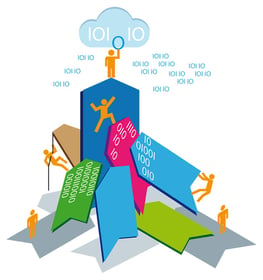The Keys To Successful Supply Chain Digitization
Nick Ostdick - November 30, 2017

 Digitization. If there’s one major buzzword in today’s global supply logistics, it may be digitization. But the movement toward an end-to-end (E2E) digitally-driven supply stream is more than simply the flavor of the day; rather, it represents a fundamental shift in the way planners and managers oversee and deploy their planning and production processes.
Digitization. If there’s one major buzzword in today’s global supply logistics, it may be digitization. But the movement toward an end-to-end (E2E) digitally-driven supply stream is more than simply the flavor of the day; rather, it represents a fundamental shift in the way planners and managers oversee and deploy their planning and production processes.
If we understand supply chain digitization as the movement toward a completely integrated sequence of planning and production solutions that work in tandem to create a more visible and agile supply stream across, then it’s clear why this topic is top priority for companies looking to remain competitive and growth-oriented in the 21st Century. Digitization not only helps companies function more efficiently and effectively, but it also provides companies the responsiveness and agility necessary to address and avoid potential breakdowns in demand planning, production, transportation, and yard or container management.
But as digitization across the supply network becomes more of a necessity, it is important for planners and managers to assess the challenges and risks associated with overhauling their supply pipelines to conform to a more digital platform. As such, companies must ask themselves: How do we successfully digitize our supply network without disrupting existing workflows and creating the desired results of a digital value stream? And, perhaps more importantly, what are the concrete steps we must to take ensure a successful digitization?
With this in mind, let’s examine the keys to successful supply chain digitization and the moves planners and managers must make to realize the full benefits of a digitized manufacturing and supply network.
Identify business moments
One of the first critical steps in digitizing a manufacturing company’s supply stream is identifying the right business moments, or the instances where the front and back office converge in a moment for growth or expansion. A business moment is a brief everyday occurrence that catalyzes a predictable series of events involving people, data, and devices spanning multiple ecosystems and environments. In today's digital business environment, a business moment may actually last only a few seconds. And as the supply chain industry increasingly moves to an Industry 4.0 framework, where data is available in real time, the scope of relevant business moments will continue to expand well beyond the supply chain. By identifying business moments, you also identify instances where it's necessary to combine data sets and sources, including your operational technology, machine logs and even social data. For example, an organization implementing postmodern ERP must use combined application and data integration techniques to integrate SaaS applications with cloud and hybrid environments,
Create space for data integration
The conventional approach to data integration and application integration actually starts with segregation: usually separate teams are established for each integration endeavor, and they have little communication with one another. This approach has multiple drawbacks:
- Increased costs due to duplicative efforts
- Delayed deployment
- Lack of economy of scale
- Failure to provide sufficient application and data infrastructure across lines of business and departments
But, in point of actual fact, supply chain leaders would be well-advised and better served to seek application and data capabilities that work together to make the entire business more agile. Rather than focusing on the integration requirements of individual applications, use cases, or projects, wise supply chain leaders look for broadly applicable, reusable capabilities that build on the interaction of aligned application and data integration infrastructure. That's the natural starting point for identifying shared benefits of application and data integration, such as more positive customer-facing interactions and optimization of shared competencies.
Deploy the right technology and tools
Application and data infrastructure are ever-evolving propositions in modern manufacturing and supply chain management, and this means planners and managers must rethink the way they evaluate providers of integration technologies. No single vendor will be able to provide every aspect of the infrastructure your organization needs; most vendors specialize in either business flow integration or data manipulation, but not both. Evaluate each potential vendor using the same criteria:
- The methods for delivering various data and application capabilities, along with how these capabilities will be integrated
- The extent to which application integration and data integration will intersect, and whether they have the ability to support a combination of relevant technologies (such as iPaaS or iSaaS)
- The ability to support the organization-wide convergence of application and data integration
The best suite of application and data integration "tools" might not address every specialized business need. But it should provide a robust infrastructure that enables interoperability, along with self-service support and end-to-end management.
Prioritize real-time capability
A truly digital supply chain must both process and deliver data at the right moment. As real-time data becomes the norm rather than the exception, this capability will grow even more critical, as will the use of data delivery styles that allow greater granularity (like data visualization). To fully enable business flows and information services, application and data integration leaders must first understand the implications of real-time requirements. From there, it's possible to seek out and identify scenarios where current business flows and existing information provide insufficient value. Online channel optimization is often an example because it may require flexible data latency and process throughput to adapt to business needs in real-time.
Making real-time capability a core element of any digitization strategy has a number of benefits. First, real-time gives planners and managers more maneuverability when it comes to how they position their planned production programs. Secondly, real-time eliminates lead times in reporting and data mining which in turn helps break down communication and planning silos across the entire production cycle. Lastly, real-time, with its ability to provide up-to-the minute insights into holistic supply situations, gives manufacturing companies more room for adjustments, modifications, and alterations to planning and production models based on customer demand, product or resource availability, and job capacity across various production facilities.
LATEST POSTS
- Understand Circular Economy in The Manufacturing Industry
- How Can Industry 4.0 IT Integration Be Achieved Smoothly?
- The Significance of Order Sequencing in Discrete Manufacturing
- How to improve your Supply Chain Management: The Power of Control Towers
- Optimizing Human Resource Scheduling in Manufacturing: A Technological Approach



